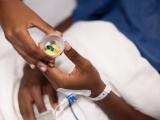A study of US patients hospitalized with gram-negative bloodstream infections (GN-BSIs) found that fewer than half of those eligible were transitioned from intravenous (IV) to oral antibiotic therapy.
The authors of the study, published today in JAMA Network Open, say the findings provide opportunities for further antibiotic stewardship interventions in the management of GN-BSIs, which are common and contribute significantly to morbidity and mortality in hospitalized patients.
Prolonged IV therapy poses risks
For the study, a team led by researchers at Johns Hopkins University School of Medicine and Trinity Health in Michigan analyzed the electronic medical records of a cohort of adults hospitalized with GN-BSIs in 2019 at 24 US hospitals. The objectives were to characterize the timing and frequency of transitioning from IV to oral therapy by day 7 and compare demographic characteristics, sources of infection, and antibiotic selection between the IV and oral groups.
The researchers note that while there is significant variability in management of GN-BSIs across hospitals, prolonged IV antibiotic therapy can pose risks such as phlebitis and venous thromboembolism and is inconvenient for both patients and nurses.
Of the 4,581 GN-BSI episodes analyzed (median age, 67years; 52.2% men), 1,969 (43%) receiving IV antibiotics were transitioned to oral therapy by day 7, and the median day of oral transition was 5. A total of 4,109 patients (89.7%) achieved clinical stability within 5 days, and source control was achieved within 7 days for 3,429 episodes (74.9%). Transitioning from IV to oral therapy by day 7 was highly variable across hospitals, ranging from 25.8% to 65.9%.
Compared with patients transitioned to oral therapy, patients maintained on IV therapy were more likely to be immunosuppressed (31.9% vs 24.6%), require intensive care unit admission (39.5% vs 17%), have fever or hypotension as of day 5 (16.2% vs 2.5%), and require kidney replacement therapy (10.7% vs 3.2%) and were less likely to have source control within 7 days (70.9% vs 80.1%).
With the knowledge that safe and effective clinical outcomes are possible in oral transition therapy, the current study suggests that many of the patients in our cohort may have had options for an earlier transition to oral therapy with a higher frequency than what was observed.
Urinary tract infections were the most common source of infection for both the oral therapy group (64.9%) and the IV therapy group (38.6%). Escherichia coli (60.4%) and Klebsiella pneumoniae (18.8%) were the most commonly isolated species in the oral group.
There were more extended-spectrum beta-lactamase–producing bacterial infections in the IV therapy group than in the oral group (10.6% vs 2.6%), and several other organisms—including Pseudomonas species (10.9% vs 5.8%), Enterobacter species (6.4% vs 4.1%), Proteus species (6.1% vs 3.9%), and Serratia species (3.9% vs 2%)—were more prevalent in IV therapy patients than those transitioned to oral therapy.
Total duration of antibiotic treatment was significantly shorter among the oral group than the IV group (median, 11 vs 13 days). Fluoroquinolones (62.2%) were the most commonly prescribed oral antibiotics, followed by beta-lactams (28.3%) and trimethoprim-sulfamethoxazole (11.5%).
Stewardship opportunities
The study authors say the fact that only 43% of patients were transitioned to oral therapy, despite roughly 90% achieving clinical stability by day 5 and approximately 75% having source control within the first week, suggests "there may be significant opportunities for early and more frequent oral antibiotic transitions."
They also note that most GN-BSIs were from urinary sources with Enterobacterales, an area of practice in which several studies support the safety and efficacy of oral transition therapy.
"With the knowledge that safe and effective clinical outcomes are possible in oral transition therapy, the current study suggests that many of the patients in our cohort may have had options for an earlier transition to oral therapy with a higher frequency than what was observed," they wrote. "Antimicrobial stewardship teams can consider developing targeted education on when transition to oral antibiotics can be considered for GN-BSIs that address patient identification, timing of transition, agent selection, and duration of therapy."






















